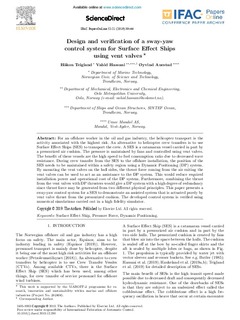Design and verification of a sway-yaw control system for Surface Effect Ships using vent valves
Journal article, Peer reviewed
Published version
Permanent lenke
http://hdl.handle.net/11250/2635240Utgivelsesdato
2019Metadata
Vis full innførselSamlinger
- Institutt for marin teknikk [3431]
- Publikasjoner fra CRIStin - NTNU [38070]
Sammendrag
For an offshore worker in the oil and gas industry, the helicopter transport is the activity associated with the highest risk. An alternative to helicopter crew transfers is to use Surface Effect Ships (SES) to transport the crew. A SES is a catamaran vessel carried in part by a pressurized air cushion. The pressure is maintained by fans and controlled using vent valves. The benefit of these vessels are the high speed to fuel consumption ratio due to decreased wave resistance. During crew transfer from the SES to the offshore installation, the position of the SES needs to be maintained within a safety region using a Dynamic Positioning (DP) system. By mounting the vent valves on the hull sides, the thrust force coming from the air exiting the vent valves can be used to act as an assistance to the DP system. This would reduce required installation power and operational cost of the DP system. Furthermore, combining the thrust from the vent valves with DP thrusters would give a DP system with a high degree of redundancy since thrust force may be generated from two different physical principles. This paper presents a sway-yaw control system for a SES to demonstrate an assisted system that is actuated purely by vent valve thrust from the pressurized cushion. The developed control system is verified using numerical simulations carried out in a high fidelity simulator.
